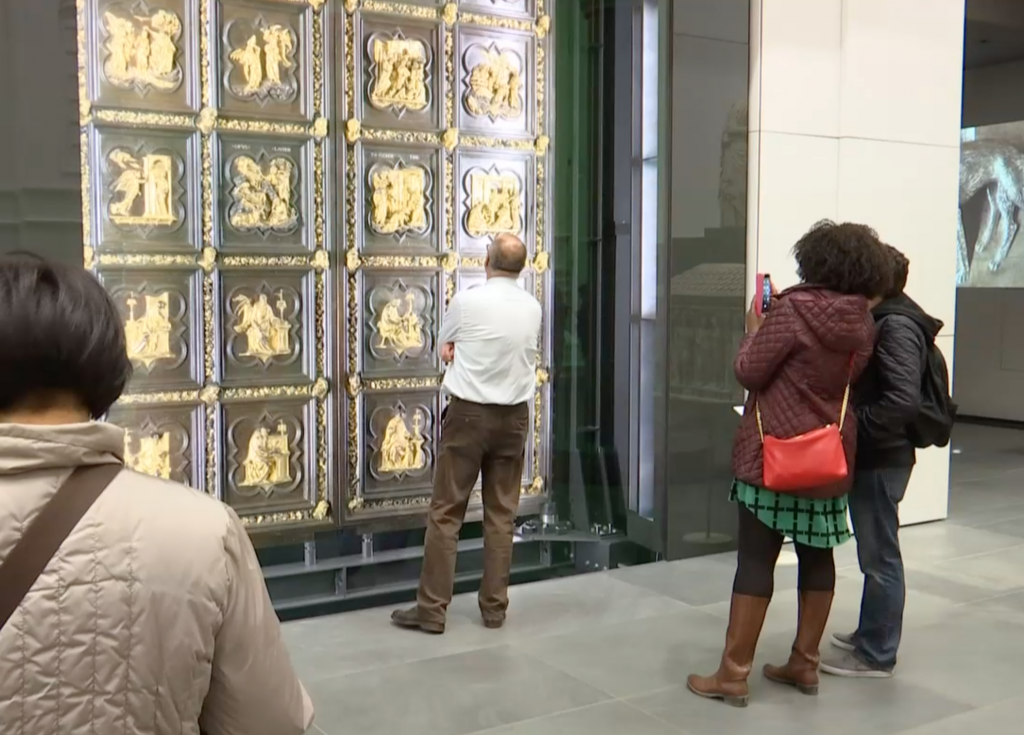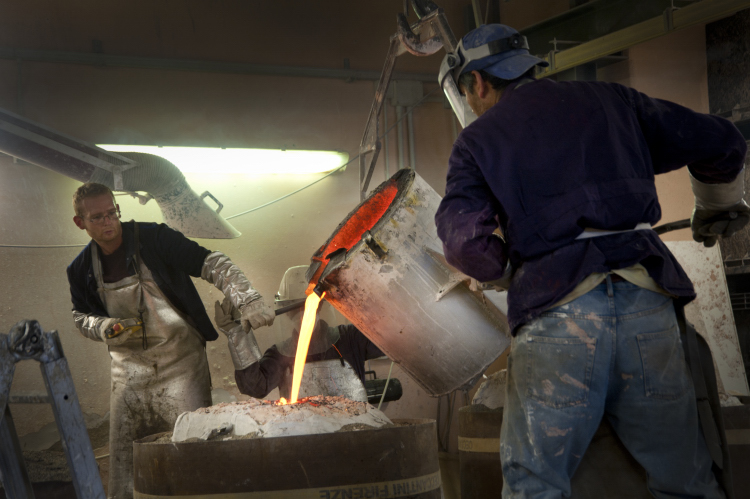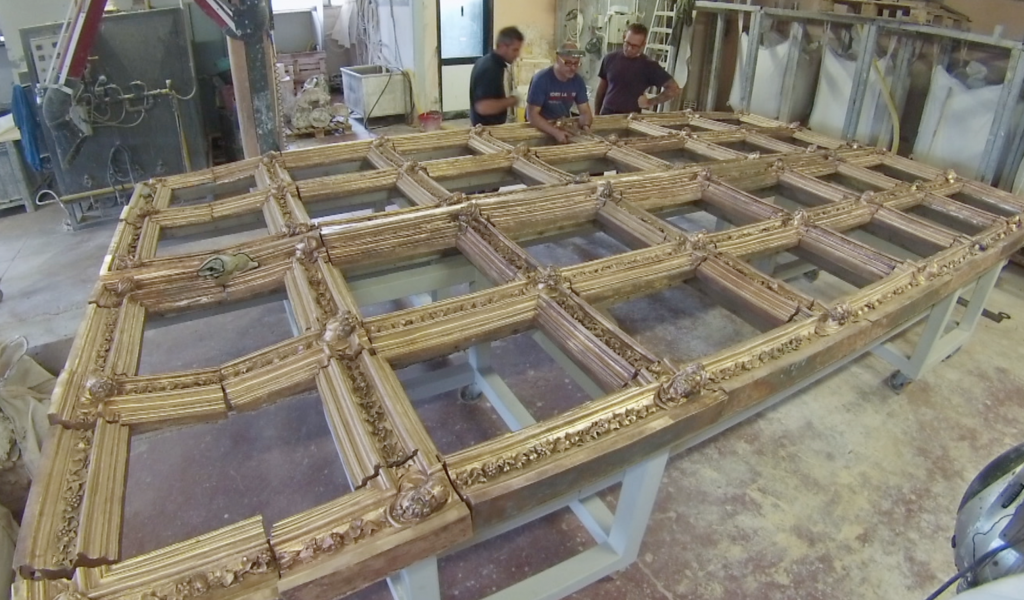
Last week I had the rare opportunity to dedicate myself for two days to a feature story in Florence, the restoration of Lorenzo Ghiberti’s North Doors on the Florence baptistery and the making of a replica. After becoming discouraged about the current situation in Rome (see last post “Ravishing, Rotten Rome”) it was refreshing to spend time in the charming, well-run city of Florence and meet with artisans and restorers who represent the best of Italy.
The story was on Lorenzo Ghiberti’s North Doors of the Florentine Baptistery.
Florentine artist, sculptor, goldsmith and architect Lorenzo Ghiberti took over 20 years to make the bronze doors completing them in 1424. The doors have 28 panels, most with scenes from the New Testament. Each panel is a bronze engraving gilded in 24-karat gold. Over the years millions of tourists have stopped to stare at the doors, but in recent years the once magnificent panels have become grime-covered and difficult to appreciate.

Over the past two had a half years a team of nine restorers has been working to restore the doors. They finished their work this fall and the completely restored doors are now on display in the Museum of the Opera Del Duomo.
The restoration began in March 2013 when the North Doors were removed from the baptistery and taken to a nearby laboratory for the restoration, no small feat given that the massive North Doors are five meters (16.4 feet) tall and 3 meters (nearly 10 feet) wide and weigh 9 tons.
Then, millimeter by millimeter, using scalpels, lasers, chemical compresses and q-tips the nine restorers worked their way over the 600-year-old Renaissance masterpiece.

As the restorers scraped off the grime, the 24-karat gold gilding came back to light, and little creatures, such as insects and a split-tailed gecko emerged.
I had the chance to interview Stefania Agnoletti, the head of the restoring team and she explained that they used scalpels, dentists’ magnifying glasses, lasers and even tiny needles to clean tiny details on the door.
On the night of September 10th workers moved the massive door from the laboratory to its new home, the New Museum of the Opera del Duomo, where it stands in an acclimatized case next to Ghiberti’s other restored door, “The Gates of Paradise.”

The restoration of the doors has gone hand in hand with the creation of an exact replica of Ghiberti’s original doors, which is nearing completion at a foundry near Florence and will be put on the Florence Baptistery in January.

The project is being funded using a method of art adoptions. Philanthropists organized by a group called the Guild of the Dome, are each paying for the restoration and replica of one of the panels. Each panel costs a donor 150,000 Euros. By adopting a panel, each donor will have his or her name etched in the back in honor of their gift. The donors are from Russia, the US, Taiwan, India, Italy, Mexico and Israel, and Europe.
Enrico Marinelli, the ebullient President of the Guild of the Dome and also President of the Frilli Gallery drove me out to the Ciglia and Carrai Foundry where the replica is being made. The Frilli Gallery also handled the creation of the replica of Ghiberti’s “Gates of Paradise” doors, which were put on the Baptistery in 1990.

Entering the foundry I was immediately accosted by the loud noise, smoke and strong fumes. Artists and artisans were busily working with bronze, hammers, wax and chisels to complete the replica of the door in time for the inauguration on the baptistery on January 23, 2016.
There are 15 artisans on the team who have been working for the past four years to create an exact replica of the Lorenzo Ghiberti’s North Door. The original doors were made using a technique called Lost Wax Bronze Casting, the same method being used to make the replica at the Ciglia and Carrai foundry.
Jacopo Ciglia, head of the team making the replica, explained the process to me. Because they were not allowed to make molds from the original panels, they used 3D laser scans to create a silicon mold. From the silicon mold they created a wax prototype. They then used the same process that Ghiberti used called “Lost Wax Casting” in which the liquid bronze is poured into the wax cast which melts away. The final stages include the chiseling of all the details and the polishing of the bronze panels.

Ciglia said it has been a tough job as they have endeavored to precisely replicate Ghiberti’s work, spending days trying to accurately copy details such as eyes and feet. He said they struggled for weeks over Christ’s belly button in the crucifixion panel noting, “It was complicated trying to capture the expression of the belly button as it was in Ghiberti’s original.”

The artisans pointed out borders on clothing, designs on helmets on warriors, and a gecko’s tail split in two, apparently a sign of good luck, along the border of the door.

Andrea Romanelli, one of the Master Chiselers was carefully chiseling the fine detail into each panel. He had a box with hundreds of small metal tools similar to those used by Ghiberti to complete his task. Romanelli proudly demonstrated for my cameraman and me how he chiseled a curl in the hair of an apostle in the panel of “The Last Supper.” He noted that his replica maintains every detail in the hairstyles, the embroidery on the cloths, and the architectural designs on the panels even in areas of the panels that would be out of sight to someone looking at the door.

While the ovens burned below, upstairs we filmed sculptor Marco Degli’Innocenti as he carefully used q-tips and small wooden implements to work on a wax prototype of the panel showing “The Temptation of Christ”. Wearing thick magnifying glasses, he worked his wooden implement around the scales on the clawed foot of the devil figure. “It is called Lost Wax Casting because the wax goes away and magically it has transformed into bronze everything that was in wax,” Degl’Innocenzi explained.

The artisans spent six months studying Ghiberti’s North Doors before beginning work on the replica which has been going on for four years. Clara Marinelli of the Frilli Gallery told me in the past four years they have used 1 ton of silicon, 400 kilos of wax and 3.5 tons of bronze to make the replica of the North Doors.


What a wonderful essay to start my day. Thank you.
If there is such a thing as reincarnation, I think I like to come back as an art restorer. What a fine way to earn one’s crust; using technology, old and modern tools & techniques, tact and patience to make what has been allowed to age, beautiful again.
I’d be interested to know why you think Florence is so much better governed than Rome .
Thank you Martha, I am glad you liked it. It was my impression that Florence is governed better than Rome for some very simple reasons. I was impressed by the fact that the historic center in Florence seemed to be functioning well as a pedestrian area. I was able to walk around without risking getting run over. In Rome all the pedestrian areas seem to have motorinos, delivery trucks and all sorts of vehicles that have a special permission to pass. In Florence I noticed that there is hardly any graffiti on the walls in the center and was told that there is some sort of urban volunteer project where volunteers paint over the graffiti. Finally I saw these really cool recycling bins that seem to be mostly underground. We now have these huge containers in Rome lined up along the streets taking up about 5 parking spaces and looking very messy. Sadly there are Rom nomads who pass by and dig in them hourly. People don’t ever seem to manage to get the right items in the right container (it is not that complicated — paper, glass, plastic) and you see things left outside and shoved in the wrong places. I did not see any of that in Florence. I could be completely wrong but it was my clear impression that Florence is run better.
What a fascinating look at Ghiberti’s doors. I am always in awe of works of art like these, but these craftsmen are also pretty awe-inspiring. How wonderful that you got to see this process close up. Thanks for sharing with us.
I feel very lucky to have had such a close up view.
Thrilled to read this story. I didn’t know that they were working on these doors or that they were going to be in my favorite Florence museum. I am taking a day from my month in Rome to go to Florence specifically to see the new museum. I was afraid it wouldn’t be open, but found out a month or so ago it would be. I have spent time looking at the first doors they did and found them marvelous.
I am also heading to Santa Croce first to see the re-done main altar, which was being worked on the last two or three times I was in Florence and also the re-done entrance to the Pazzi Chapel which I contributed to through a fund raiser.
It will be a busy day in a city I wish I could spend more time in, but I will see a couple of my favorites.
I arrive in Rome on December 17, can’t wait.
A presto,
Joan
How amazing that they are doing this. Thanks for the inside scoop.
What a beautiful and brilliant post, Trisha. Thank you for the great insight into the world of restoration and what a huge undertaking this can be. But what loving work these artists do – I find it amazing. I find it difficult to go to Florence anymore. I went on a return trip a few years ago, but was heartbroken to see ‘sellers’ with their fake “Guccio” bags spread out over historical monuments and churches without any respect to the places they were covering their fake cr@p with. (Sorry, it really makes me angry). I left the city after a day, checked out early. I went back last year, but only for a day trip to visit the Medici tombs. I didn’t find it any better, sadly enough because I would love to spend a few more days there revisiting the Uffizi and the Duomo – and the fantastic Museo del Duomo (what a great little museum that is never crowded, but has some amazing pieces). Maybe I will give it another try…
Thank you for your comment Kay. I felt so lucky on this trip to Florence because I was taken around by the charming Enrico Marinelli, President of the Guild of the Dome, who knows everyone in the art world in Florence. He took me to see the hidden Michelangelo sketches on the walls of a basement area under the Medici Chapel — truly amazing, then with my cameraman to see the Medici Tapestries in the Palazzo della Signoria by Pontormo and Bronzino. We also got to visit the Museo dell’Opera del Duomo and see, in addition to the restored North Doors and Gates of Paradise, the wooden sculpture of the Penitent Magdalene by Donatello which was impressive as well as “the Deposition” sculpture by Michelangelo. So, we were swept along from one fabulous experience to another and never noticed the sleazy sellers. I was very lucky.
It is amazing and I was thrilled to have the opportunity to go behind the scenes and see the work in progress. I was also so impressed by the passion of all those involved, both the chief restorer who I interviewed, and all the artists/artisans and other individuals involved in the making of the replica.
Astonishing! What an amazing project – would have loved to have joined you on your tour. The skills of old, enhanced by modern materials and technology are alive and well.
I wish you could have been there Alan. You would have loved it. I thoroughly enjoyed talking to the artisans. They took enormous pride in their work. I asked Andrea Romanelli to tell me his title and he said it was “Master Artist” — he deserves that title. He showed me the hundreds of different chiseling tools he had and said they were the exact same type that Ghiberti and his team had used — he had studied it and he knew. He was determined to get every last mark in the bronze precisely the same as the original. There was such pride in his work. The same was true for all of them whether they were working the wax or fusing the bronze. I was so impressed.
What a wonderful article. I did not know this restoration was under way. I am pleased to hear of it. I remember learning about the doors at school, and then finally seeing them many, many years ago. I was just amazed at the beauty and scope of the doors. Additionally, I am in awe of restorers. Artists and technicians both, they do such painstaking work. Thanks for this one!
Thank you Adri — the doors are really spectacular.